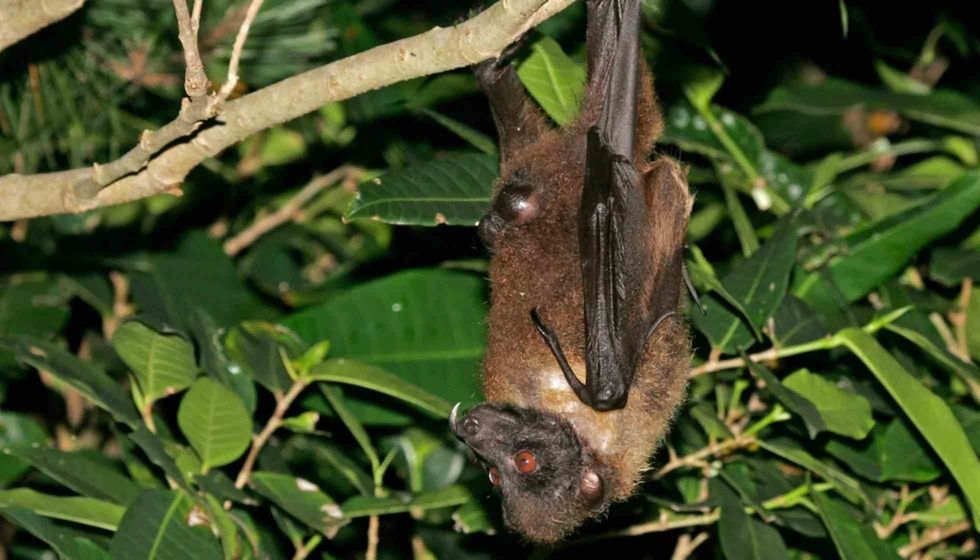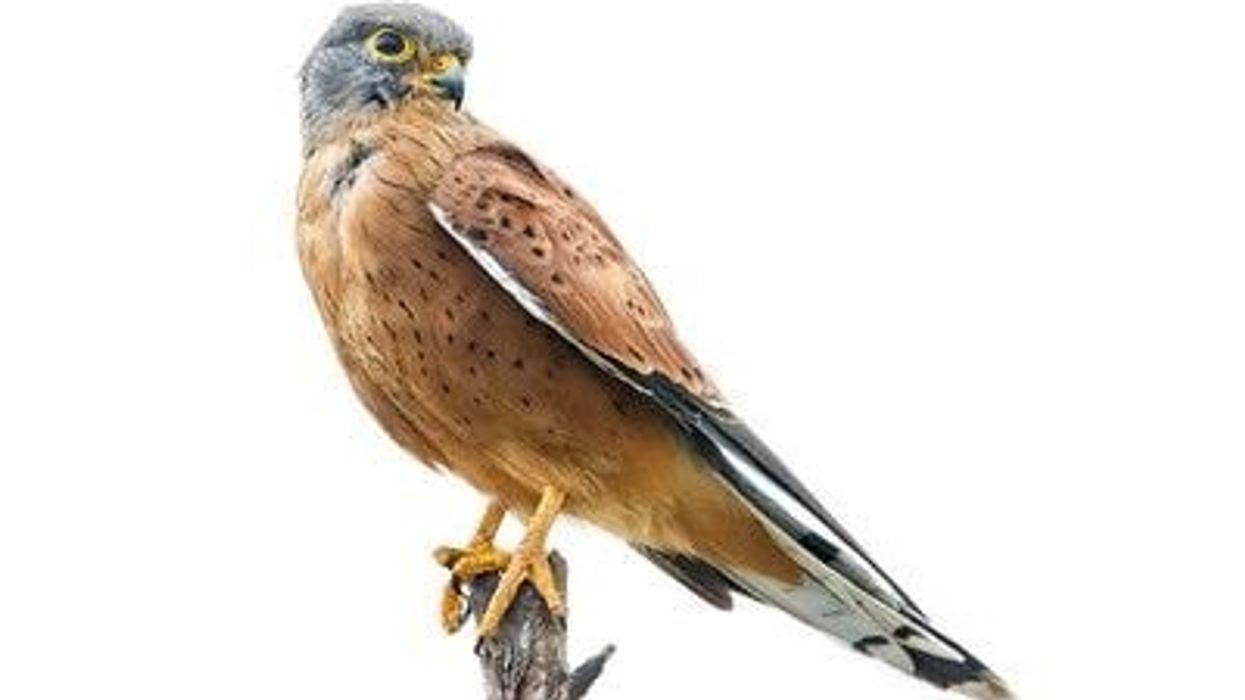The Ryukyu flying fox (Pteropus dasymallus) is a megabat and fruit bat species that gets its name from its native habitat, the Ryukyu Archipelago in Japan. It is also found in the Philippines and in Thailand.
It is a bat that does not depend on echolocation, but rather uses its sense of smell and vision to get around and find food.
This fruit bat also has large fox-like eyes, hence its name. It is one of the fruit bats that depends on a variety of fruits and leaves for its diet.
It has a liking for figs and also eats insects sometimes. It is known for roosting during the daytime with others of its species and feeds during the night.
Females of the species give birth to a singular young one. As bats, they carry viruses that may be transmitted when humans come in close contact with them, but they are not aggressive towards humans.
Ryukyu flying fox fruit bats inadvertently disperse the seeds of important plants and hence are essential pollinators, even though they are not ideal for orchards.
Habitat loss and hunting for food have resulted in this species coming under threat and being given a Vulnerable status by the International Union for Conservation of Nature (IUCN). Sadly, a number of these bats tend to get entangled in nets meant to protect a fruit plant or crops.
Learn more interesting facts about mammals like the red bat and the greater mouse-eared bat here on Kidadl.
Ryukyu Flying Fox Interesting Facts
What type of animal is a Ryukyu flying fox?
The Ryukyu flying fox (Pteropus dasymallus) is a megabat and fruit bat.
What class of animal does a Ryukyu flying fox belong to?
The Ryukyu flying fox (Pteropus dasymallus) fruit bat belongs to the Mammalia class of animals
How many Ryukyu flying foxes are there in the world?
There are estimated to be about 3,000-6,000 mature individuals of the Ryukyu flying fox (P. dasymallus) species in the world.
Where does a Ryukyu flying fox live?
The Ryukyu flying fox (P. dasymallus) is a fruit bat that lives in a range of tropical and subtropical dry forests and swamps in Asia, mainly the Ryukyu Islands in Japan.
What is a Ryukyu flying fox's habitat?
The Ryukyu flying fox (P. dasymallus) is found in the countries of Taiwan and Japan. The typical Ryukyu flying fox range also covers the Philippines. These countries fall in the tropical and subtropical zones.
In these zones, Ryukyu flying fox fruit bats like to make a habitat in a dry forest or swamp. This bat likes roosting on trees in the forests during the daytime. Being a bat, it forages around the forest and swamp for fruits and leaves of various trees at night.
Who do Ryukyu flying foxes live with?
Ryukyu flying fox bats (Pteropus dasymallus) are seen roosting on trees, alone, in small groups, or in large colonies.
How long does a Ryukyu flying fox live?
The Ryukyu fruit bat (Pteropus dasymallus) may live anywhere between 10-24 years.
How do they reproduce?
Ryukyu flying fox bats (Pteropus dasymallus) reproduce by mating and giving birth to young bats. The breeding season is from November to January. Females are able to give birth once they are two years of age. The gestation period lasts for four to six months, and a single pup is born in May or June.
What is their conservation status?
The conservation status of Ryukyu flying fox bats (Pteropus dasymallus), according to the International Union for Conservation of Nature (IUCN), is currently Vulnerable.
Ryukyu Flying Fox Fun Facts
What do Ryukyu flying foxes look like?
The five subspecies of Ryukyu flying fox fruit bats only show a minimal amount of differences in biology; their general description does not alter a lot. Compared to Indian flying fox bats, the body of the Ryukyu flying fox species is smaller.
Ryukyu flying foxes are usually 8-9 in (20.3-22.9 cm) in length, with their forearms measuring around 5.5 in (14 cm). They have impressive wingspans of around 4 ft 1 in–4 ft 8 in (1.24-1.41 m), and they usually weigh around 0.88–1.10 lb (400-500 g).
The wings of this megabat species are dark brown, whereas its overall fur is brown and an accurate description of its body color would be reddish-brown or between black and brown.
The Ryukyu flying fox species has yellowish-white napes and pointed small ears. It has a woolly appearance due to having long hair and fur all over its body.
Populations of this bat also have pointed muzzles and large fox-like eyes. The color of the throat and neck may be lighter in some subspecies.

How cute are they?
Ryukyu flying foxes have the cutest fox-like faces with big eyes. These Japanese fruit bats are also sociable and intelligent. They have impressive wingspans and have beautiful furry hair. Being a megabat and a flying fox species, they are also highly intelligent and social animals. They are completely harmless unless you come in close contact with them.
How do they communicate?
Ryukyu flying fox (Pteropus dasymallus) populations have well-developed eyesight and a good sense of smell. Being a flying fox species, they do not use echolocation.
Ryukyu flying foxes are vocal creatures. They communicate within their small groups using their voices around campsites and at night, in feeding areas. These Japanese flying foxes are especially noisy when breeding season comes around because they become territorial at this time, and noisily defend their territories.
How big is a Ryukyu flying fox?
A Ryukyu flying fox is 8-9 in (20.3-22.9 cm) in length, has a wingspan of 4 ft 1 in–4 ft 8 in ( 1.24-1.41 m). This makes them seven to eight times bigger than Kitti's hog-nosed bat.
How fast can a Ryukyu flying fox move?
Ryukyu flying foxes, much like other flying fox species, can move at speeds of around 13 mph (6 m/s) and are even known to reach speeds of 19 mph (8.6 m/s).
How much does a Ryukyu flying fox weigh?
Ryukyu flying foxes weigh around 0.88–1.10 lb (400-500 g).
What are their male and female names of the species?
Males and females of the Ryukyu flying fox species do not have specific names.
What would you call a baby Ryukyu flying fox?
A baby Ryukyu flying fox may be called a 'pup'.
What do they eat?
The typical Ryukyu flying fox diet consists mainly of fruits and leaves of different trees. They have a fondness for figs, but also eat many other fruits, flowers, leaves, and even insects.
Are they poisonous?
Ryukyu flying fox populations are not directly poisonous to humans, but they do pose a threat as a source of viruses and consequent diseases which can be fatal, such as the Australian bat lyssavirus and Hendra virus.
Would they make a good pet?
The Ryukyu fruit bat (Pteropus dasymallus) cannot really be kept as a pet as it is unethical to cage up these Japanese fruit bats.
They survive and live through smells, and are very social animals, and will not do well in a captive environment. They may not survive long outside their natural habitat as they need to forage freely for food for their largely frugivorous diet.
These bats can survive for only up to two years in captivity compared to a 10-24 year lifespan in the wild, showing that their lives come under serious threat when locked up.
Did you know...
The Ryukyu flying fox belongs to the Animalia Kingdom, phylum Chordata. All vertebrates belong to the Animal Kingdom, phylum Chordata.
Orii's flying fox (Pteropus dasymallus inopinatus) is a subspecies of Ryukyu flying fox fruit bats. This Pteropus dasymallus inopinatus subspecies feeds on a total of 78 different plant and fruit species.
A high number of Ryukyu flying fox bats are often found to get entangled in nets in Japan near orchards or fields of crops. They are also electrocuted by electricity lines sometimes. Conservation of these bats is paramount since they are a vulnerable species. Increased habitat loss and hunting for meat have also threatened the existence of this species.
Ryukyu flying foxes fall under the kingdom Animalia. All bats and megabats of the flying fox description fall under this kingdom.
Ryukyu flying foxes are natural pollinators as they disperse seeds that are essential to natural and plant industries such as timber, crops of food, and medicine.
On the island of Yakushima, the Ryukyu flying fox is found less often than on Kyushu Island. In Taiwan, after being constantly threatened, the species and its subspecies are currently classified as Endangered by the IUCN.
One subspecies of Ryuku flying foxes was the Taiwanese fruit bat (Pteropus dasymallus formosus). Sadly the Pteropus dasymallus formosus is now extinct according to the IUCN.
Fruits are not the only plant part that the Ryukyu flying fox eats, its diet also consists of flowers and plant bark sometimes.
In the Philippines, a distribution of the Ryukyu flying fox is observed on Batanes Island and the Babuyan Islands. More specifically in the Babuyan Archipelago of the Philippines, this species occurs on Dalupiri Island and Fuga Island.
Also, there are numerous islands in Japan where the Ryukyu flying fox is found, mainly in the Ryuku Archipelago. The Tokara Archipelago in the Satsunan Islands, Okinawa and Ishigaki Islands, and Iriomote-Jima in the Yaeyama Islands are some more of the places in Japan where a distribution of these flying foxes is observed.
Other habitats in Japan include the Hatoma, Yonakuni, and Obama islands. Even though Japan is its native land, populations are in decline there.
Are Ryukyu flying foxes dangerous?
No, Ryukyu flying fox fruit bats are not physically dangerous to humans. The only threats they pose to a human are if we come in close contact with these animals, contract a virus that the bat carries and suffer from the subsequent disease.
Are Ryukyu flying foxes aggressive?
No, Ryukyu flying fox fruit bats are not aggressive towards humans. They pose no physical threats if left alone. If a human tries to handle the bat, it may try to scratch you, but nothing more. They are aggressive with their own species during the breeding season because they get territorial.
Here at Kidadl, we have carefully created lots of interesting family-friendly animal facts for everyone to discover! Learn more about some other mammals from our water vole facts and megabats facts pages.
You can even occupy yourself at home by coloring in one of our free printable Ryukyu flying fox coloring pages.









